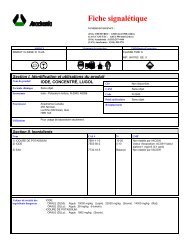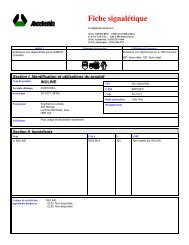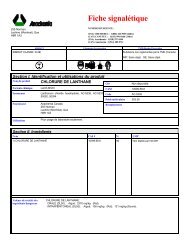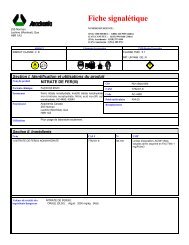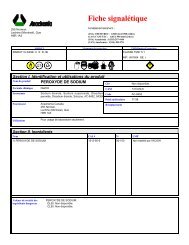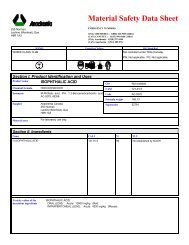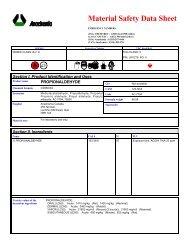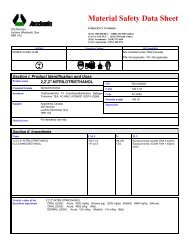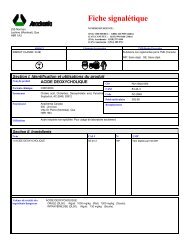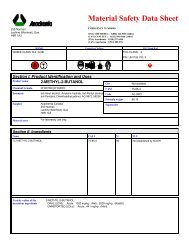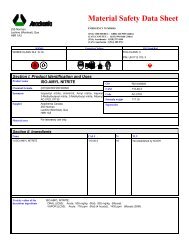2822 SODIUM DICHROMATE (English) ANACHEMIA MSDS ...
2822 SODIUM DICHROMATE (English) ANACHEMIA MSDS ...
2822 SODIUM DICHROMATE (English) ANACHEMIA MSDS ...
You also want an ePaper? Increase the reach of your titles
YUMPU automatically turns print PDFs into web optimized ePapers that Google loves.
255 Norman.<br />
Lachine (Montreal), Que<br />
H8R 1A3<br />
Section I. Product Identification and Uses<br />
Product name <strong>SODIUM</strong> <strong>DICHROMATE</strong><br />
Chemical formula<br />
Synonyms<br />
Material uses<br />
Na2Cr2O7.2H2O<br />
Section II. Ingredients<br />
Sodium bichromate dihydrate, Dichromic acid disodium<br />
salt, AC-8334, AC-8334T, 82248, 82260<br />
Anachemia Canada.<br />
255 Norman.<br />
Lachine (Montreal), Que<br />
H8R 1A3<br />
For laboratory use only.<br />
Material Safety Data Sheet<br />
WHMIS Protective Clothing TDG Road/Rail<br />
WHMIS CLASS: D-1A C D-2A TDG CLASS: 6.1 5.1<br />
Supplier<br />
CI#<br />
CAS# 7789-12-0<br />
Code AC-8334<br />
Formula weight<br />
Supersedes<br />
PIN: UN3086 PG: II<br />
Not available.<br />
1) <strong>SODIUM</strong> <strong>DICHROMATE</strong> DIHYDRATE 7789-12-0 90-100 Exposure limits: ACGIH (Water-soluble<br />
Cr VI compounds (as Cr)) TWA 0.05<br />
mg(Cr)/m3:<br />
Toxicity values of the<br />
hazardous ingredients<br />
<strong>SODIUM</strong> <strong>DICHROMATE</strong>:<br />
ORAL (LD50): Acute: 50 mg/kg (Rat).<br />
EMERGENCY NUMBERS:<br />
(USA) CHEMTREC : 1(800) 424-9300 (24hrs)<br />
(CAN) CANUTEC : 1(613) 996-6666 (24hrs)<br />
(USA) Anachemia : 1(518) 297-4444<br />
(CAN) Anachemia : 1(514) 489-5711<br />
Name CAS # %<br />
298.04<br />
TLV<br />
5.1
Section III. Physical Data<br />
Physical state and<br />
appearance / Odor<br />
pH (1% soln/water)<br />
Odor threshold<br />
Percent volatile<br />
Freezing point<br />
Boiling point<br />
Specific gravity<br />
Vapor density<br />
Vapor pressure<br />
Water/oil dist. coeff.<br />
Evaporation rate<br />
Solubility<br />
Solid. (Reddish to orange crystals. Odorless.)<br />
3.5 (10% aqueous solution)<br />
Not available.<br />
0% at 21°C<br />
Dehydrates at 100°C.<br />
Decomposes at 400°C.<br />
2.52 (Water = 1)<br />
Not applicable.<br />
Not applicable.<br />
Not available.<br />
Not applicable.<br />
74% (in H2O) at 20°C.<br />
Section IV. Fire and Explosion Data<br />
Flash point<br />
Flammable limits<br />
Auto-ignition temperature<br />
Fire degradation<br />
products<br />
Fire extinguishing<br />
procedures<br />
Fire and Explosion<br />
Hazards<br />
None<br />
Not available.<br />
Not available.<br />
Section V. Toxicological Properties<br />
<strong>SODIUM</strong> <strong>DICHROMATE</strong> page 2/4<br />
Use flooding quantities of water. Wear adequate personal protection to prevent contact with material or its combustion products.<br />
Self contained breathing apparatus with a full facepiece operated in a pressure demand or other positive pressure mode. Cool<br />
containing vessels with flooding quantities of water until well after fire is out. Move containing vessels from fire if without risk.<br />
Powerful oxidizing agent; may ignite oxidizable materials. Contributes to combustion of other materials. Contact with<br />
other material may cause fire and/or explosion. Contact with other material may form shock, heat or friction sensitive<br />
mixtures. Container explosion may occur under fire conditions or when heated. Emits toxic fumes under fire conditions.<br />
Routes of entry Inhalation and ingestion. Eye contact. Skin contact. Skin absorption.<br />
Effects of Acute<br />
Exposure<br />
Skin<br />
Inhalation<br />
Ingestion<br />
Chromium and sodium oxides.<br />
May be fatal by ingestion, inhalation or skin absorption. Severe irritant! Potentially harmful amounts can cause damage to<br />
kidneys, liver, blood, lungs, eyes, skin, respiratory system, and/or bone marrow.<br />
Eye Causes conjunctivitis, severe irritation or burns and loss of vision. May cause permanent damage.<br />
Causes severe irritation. Prolonged exposure may result in skin burns and ulcerations. Contact with broken skin may lead to<br />
formation of firmly marginated "chrome sores". Massive overexposure could lead to damage to the kidneys, liver, blood, and/or<br />
bone marrow, kidney failure and death. A strong sensitizer which may cause skin rash.<br />
Inhalation of dust or mist may irritate the nasal septum and respiratory tract. Destructive to tissues of mucous<br />
membranes. Prolonged or repeated exposure may cause ulceration and perforation of the nasal septum. May cause<br />
headache, nausea, vomiting, chemical pneumonitis and pulmonary edema. May cause sensitization by inhalation. Can<br />
cause liver, kidney, and lung damage.<br />
Burns in mouth, pharynx and gastrointestinal tract (can cause severe tissue destruction.). May cause vomiting, nausea,<br />
abdominal pain, fever, diarrhea, coma, bleeding and/or tissue ulceration, gastroentritis, toxic nephritis with glycosuria,<br />
blood and bone marrow damage, liver and kidney failure, peripheral vascular collapse and death. Estimated lethal dose is<br />
5 g.
Section V. Toxicological Properties<br />
Effects of Chronic<br />
Overexposure<br />
Section VI. First Aid Measures<br />
Eye contact<br />
Skin contact<br />
Inhalation<br />
Ingestion<br />
Stability<br />
Hazardous decomp.<br />
products<br />
Incompatibility<br />
DO NOT induce vomiting. If conscious, wash out mouth with water. Have conscious person drink several glasses of<br />
water to dilute. Guard against aspiration into lungs. If spontaneous vomiting occurs, have victim lean forward with head<br />
down to avoid breathing in of vomitus. Seek immediate medical attention. Never give anything by mouth to an<br />
unconscious or convulsing person.<br />
Section VII. Reactivity Data<br />
Reaction Products<br />
Stable. Conditions to avoid: High temperatures, sparks, open flames and all other sources of ignition, contamination.<br />
Not available.<br />
<strong>SODIUM</strong> <strong>DICHROMATE</strong> page 3/4<br />
Dermatitis, conjunctivitis, "chrome sores", ulceration and perforation of the nasal septum. There is sufficient evidence of the<br />
carcinogenicity of this substance in humans (known carcinogen). This substance is known to cause allergic reactions in<br />
certain individuals once they become sensitized after exposure to even small amounts over a period of time. Chromium(VI)<br />
compounds in the form of chromates and dichromates have been found to be mutagenic in bacterial and mammalian cells,<br />
including those of the chinese hamster. Passes through the placental barrier in animal. Repeated or prolonged exposure to<br />
the substance can produce target organs damage. To the best of our knowledge, the chemical, physical, and toxicity of this<br />
substance has not been fully investigated. Teratogenic effects: Not available. Toxicity of the product to the reproductive<br />
system: Not available. Medical conditions which may be aggravated: Individuals with peexisting diseases of skin, asthma,<br />
allergies or known sensitization to chromic acid or chromates may be more susceptible to the effects of this material.<br />
Immediately flush eyes with copious quantities of water for at least 15 minutes holding lids apart to ensure flushing of the<br />
entire surface. Washing within 1 minute is essential to achieve maximum effectiveness. Seek immediate medical<br />
attention.<br />
Immediately flush skin with plenty of water and soap for at least 15 minutes while removing contaminated clothing and<br />
shoes. Seek immediate medical attention. Wash contaminated clothing before reusing. Discard contaminated leather<br />
articles such as shoes and belt.<br />
Remove patient to fresh air. Administer approved oxygen supply if breathing is difficult. Administer artificial respiration or<br />
CPR if breathing has ceased. Seek immediate medical attention.<br />
Organic materials, reducing agents, combustible materials, acids, alcohols, acetone, hydrazine, hydroxylamine,<br />
hydroxylamine salts, mercury cyanide, calcium hydroxide, ethylene glycol, oils, grease, oxidizing agents, boron, easily<br />
oxidizable materials, silicon, tungsten, sulfuric acid, iron, carbides, sulfur, aluminum, acetic anhydride, amines, aniline,<br />
2-propanol, trinitrotoluene, ethanol, paper. This product is a mild oxidizer in solution, but a strong oxidizer in highly acidic<br />
solutions.<br />
Contact with other material may cause fire and/or explosion. Product dehydrates at 100°C and decomposes at 400°C.<br />
Hazardous polymerization will not occur.
Section VIII. Preventive Measures<br />
Protective Clothing in<br />
case of spill and leak<br />
Spill and leak<br />
Waste disposal<br />
Storage and Handling<br />
Wear self-contained breathing apparatus, rubber boots and heavy rubber gloves. Full suit.<br />
Evacuate the area. Eliminate all sources of ignition. Sweep up and place in container for disposal. Avoid raising dust.<br />
Use non-sparking tools. Ventilate area and wash spill site after material pick up is complete. DO NOT empty into drains.<br />
DO NOT touch damaged container or spilled material. Avoid contact with a combustible material (wood, paper, oil,<br />
clothing...).<br />
According to all applicable regulations. Harmful to aquatic life at low concentrations. Can be dangerous if allowed to enter<br />
drinking water intakes. Do not contaminate domestic or irrigation water supplies, lakes, streams, ponds, or rivers.<br />
Store in a cool place away from heated areas, sparks, and flame. Store in a well ventilated area. Store away from incompatible<br />
materials. Do not add any other material to the container. Do not wash down the drain. Do not breathe dust. In case of insufficient<br />
ventilation, wear suitable respiratory equipment. Keep away from combustible material. Keep away from direct sunlight or strong<br />
incandescent light. Keep container tightly closed and dry. Manipulate under an adequate fume hood. Avoid raising dust. Use<br />
non-sparking tools. Empty containers may contain a hazardous residue. Handle and open container with care. Minimize dust<br />
generation and exposure - use dust mask or appropriate protection. Take off immediately all contaminated clothing. Avoid contact<br />
with a combustible material (wood, paper, oil, clothing...). This product must be manipulated by qualified personnel. Do not get in<br />
eyes, on skin, or on clothing. Wash well after use. In accordance with good storage and handling practices. Do not allow smoking<br />
and food consumption while handling. Wear clean work-clothing daily. Product is highly hygroscopic. Do not store on wood floors.<br />
Section IX. Protective Measures<br />
Protective clothing<br />
Section X. Other Information<br />
<strong>SODIUM</strong> <strong>DICHROMATE</strong><br />
page 4/4<br />
Face shield and splash goggles. Impervious rubber gloves, apron, coveralls, and/or other resistant protective clothing. Sufficient to protect<br />
skin. A OSHA/MSHA jointly approved respirator is advised in the absence of proper environmental controls. If more than TLV, do not breathe<br />
vapor. Wear self-contained breathing apparatus. Do not wear contact lenses. Make eye bath and emergency shower available. Ensure that<br />
eyewash station and safety shower is proximal to the work-station location.<br />
Engineering controls Use in a chemical fume hood to keep airborne levels below recommended exposure limits. Do not use in unventilated<br />
spaces.<br />
Special Precautions or Powerful oxidizing agent; may ignite oxidizable materials. Highly toxic! Severe irritant!<br />
comments<br />
Prolonged exposure may result in skin burns and ulcerations. Carcinogen! Mutagen!<br />
Sensitizer! Possible risks of irreversible effects. Toxic effects may be delayed. Do not breathe<br />
dust. Avoid all contact with the product. Avoid prolonged or repeated exposure. Use in a<br />
chemical fume hood. Keep away from heat, sparks and flame. Use non-sparking tools. When<br />
contaminated, it is very sensitive. Contact with other material may form shock, heat or friction<br />
sensitive mixtures. Handle and open container with care. Container should be opened only by a<br />
technically qualified person.<br />
NOTE TO PHYSICIAN: Massive overexposure to solutions of this product could lead to kidney<br />
failure and death. Death has been avoided in several such cases through the use of early renal<br />
dialysis. It has been reported there is little value from chelating agents, however, that ascorbic<br />
acid administered intravenously is an effective antidote in preventing renal failure. Skin ulcers<br />
may be treated by removal from exposure, daily cleansing and debridement, and application of<br />
antibiotic cream and dressing.<br />
RTECS NO: HX7750000 (Sodium dichromate dihydrate).<br />
Prepared by <strong>MSDS</strong> Department/Département de F.S.. Validated 21-Jul-2011<br />
EMERGENCY NUMBERS:<br />
(USA) CHEMTREC :<br />
1(800) 424-9300 (24hrs)<br />
(CAN) CANUTEC :<br />
1(613) 996-6666 (24hrs)<br />
(USA) Anachemia :<br />
1(518) 297-4444<br />
(CAN) Anachemia :<br />
1(514) 489-5711<br />
NFPA<br />
While the company believes the data set forth herein are accurate as of the date hereof, the company makes no warranty with respect thereto<br />
and expressly disclaims all liability for reliance thereon. Such data are offered solely for your consideration, investigation and verification.



